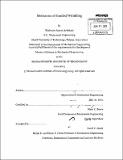| dc.contributor.advisor | Mary C. Boyce. | en_US |
| dc.contributor.author | Raayai Ardakani, Shabnam | en_US |
| dc.contributor.other | Massachusetts Institute of Technology. Department of Mechanical Engineering. | en_US |
| dc.date.accessioned | 2013-10-24T17:36:00Z | |
| dc.date.available | 2013-10-24T17:36:00Z | |
| dc.date.copyright | 2013 | en_US |
| dc.date.issued | 2013 | en_US |
| dc.identifier.uri | http://hdl.handle.net/1721.1/81621 | |
| dc.description | Thesis (S.M.)--Massachusetts Institute of Technology, Dept. of Mechanical Engineering, 2013. | en_US |
| dc.description | Cataloged from PDF version of thesis. | en_US |
| dc.description | Includes bibliographical references. | en_US |
| dc.description.abstract | The properties of a surface depend on the inherent material and the surface topography. Nature uses surface texture as a means to impact different surface behavior such as cleanliness, adhesion control, drag reduction, etc. As one way to mimic nature to obtain particular surface properties, different methods have been used to alter surface topography including surface wrinkling. Through buckling of a thin film of stiff material bonded to a substrate of a softer material, wrinkled patterns can be created by inducing compressive stress in the thin film. Using this same principle, changing the geometry of the surface or other means of creating a gradient in the stress distribution along the film, a gradient in the wrinkle topography can be created. The graded wrinkles possess varying amplitudes and wave lengths along the length of the film. In this work, the mechanics of graded wrinkling are first investigated through analytical modeling. Then, using finite element analysis, different aspects of graded wrinkling such as the wrinkle profile, stress and strain distributions are explored. Afterwards, different methods for creating wrinkled surfaces are introduced. In this work, the method of mechanical stretch and release is used for creating the wrinkled surfaces. PDMS sheets were prepared and coated with a stiff polymer using the method of initiated Chemical Vapor Deposition. The results of the graded wrinkling experiments are then presented and the trends are compared with the trends found through the finite element analysis. | en_US |
| dc.description.statementofresponsibility | by Shabnam Raayai Ardakani. | en_US |
| dc.format.extent | xii, 92 p. | en_US |
| dc.language.iso | eng | en_US |
| dc.publisher | Massachusetts Institute of Technology | en_US |
| dc.rights | M.I.T. theses are protected by
copyright. They may be viewed from this source for any purpose, but
reproduction or distribution in any format is prohibited without written
permission. See provided URL for inquiries about permission. | en_US |
| dc.rights.uri | http://dspace.mit.edu/handle/1721.1/7582 | en_US |
| dc.subject | Mechanical Engineering. | en_US |
| dc.title | Mechanics of graded wrinkling | en_US |
| dc.type | Thesis | en_US |
| dc.description.degree | S.M. | en_US |
| dc.contributor.department | Massachusetts Institute of Technology. Department of Mechanical Engineering | |
| dc.identifier.oclc | 859149838 | en_US |
